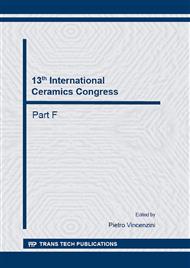p.100
p.110
p.115
p.121
p.127
p.133
p.138
p.148
p.159
Effect of Alternative Materials Added to the Plaster Composition
Abstract:
In this study, the effect of alternative additives on the properties spred diameter, setting time, bending strength and water absorption of sanitaryware plaster moulds was investigated. The plaster was partially replaced by the alternative additives such as perlite, diatomite and glass beads. Microstructural features of the resultant compositions were determined by scanning electron microscope (SEM). Finally, represantative moulds were produced and their performance was investigated under industrial conditions. It was observed that perlite and diatomite addition deteriorated the strength of plaster moulds and there was no noticeable effect of these additives on casting performance of the plaster moulds. Morever, the presence of glass beads in plaster decreased weight of the moulds without deterioration of moulds service life.
Info:
Periodical:
Pages:
127-132
Citation:
Online since:
October 2014
Authors:
Keywords:
Price:
Сopyright:
© 2014 Trans Tech Publications Ltd. All Rights Reserved
Share:
Citation:


